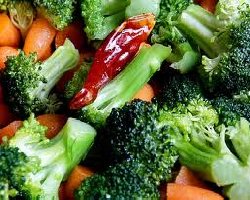Herbaceous plants (vegetables) constituted the main food for man in ancient times and he would eat them raw. Later, he got to know the value of fire and found that if he exposed the vegetables to heat, it would cause a change of taste and smell and they would become easier for him to digest. Most people need to eat more of this group of foods to provide themselves with vitamins, minerals, and fibers. Vegetables vary markedly in their nutritional value according to the different parts of the plant used in food.
Classification of vegetables:
1. Root vegetables, which include: carrots, beets, turnips and so on.
2. Tuber vegetables, which include: potatoes, taro, sweet potatoes and so on.
3. Bulbous vegetables, which include: onions, garlic, leeks and so on.
4. Leafy vegetables, which include: cabbage, spinach, purslane, mallow, lettuce, grape leaves, chard, dill, mint, parsley, watercress and so on.
5. Flowery vegetables, which include cauliflower and so on.
6. Fruity vegetables, which include: tomatoes, eggplant, squash, okra, peppers, cucumbers, cantaloupe, watermelon, and melons.
7. Stems and seeded vegetables, which include: black-eyed peas, peas, kidney beans, beans, coriander, cumin, anise, caraway and so on.
The nutritional value of vegetables:
1. Vegetables provide the body with vitamins, such as: vitamin A, C and Folate, and provide it with minerals, such as: iron, and magnesium – and they are a group which is low in fat and an important source of fibre.
2. They are characterized by being a source of carbohydrates as in seeds and tubers, except for some kinds, such as: cocoa and olives, which are a source of fatty materials.
3. Fats: They differ from fats found in meat in that the former tends to liquidity, but their nutritional value is similar to them.
4. Albumens: The nutritional value of albumens in vegetables is low, and, therefore, vegetables alone cannot serve as a source of albumens, which exist in beans in a large proportion.
5. Water: the percentage of water in vegetables is very large ranging between 70 and 90 and making their calorie value small in comparison to their size.
6. Cellulose: Cellulose exists in abundance in vegetables. It is not absorbed in the body, but remains in the intestine in its natural form. It helps the intestines to move and works as a natural laxative. Therefore, some drugs are developed from cellulose for the treatment of constipation, and on this basis frequently eating vegetables is prescribed for people who suffer from constipation.
7. Vitamins: Vegetables contain a large amount of vitamins, which vary according to the different types of vegetables. The most important vitamin is (C), which prevents skin infections and fever. It is found largely in vegetables that are eaten raw because it is destroyed by heat.
8. Minerals: All vegetables are rich in essential minerals and acids, most notably, potassium and iron.
The right choice of vegetables:
1. Vegetables should be fresh because rotten vegetables become easily fermented, particularly the green types.
2. They should be chosen seasonally in order to be young with soft fibers, and thus have a special flavor.
3. Green vegetables should be bright in color, and the stems should be easy to break. In cabbages, choose the one which is full of wide leaves; in cauliflowers, choose the one that is white and large; in kidney beans, choose the medium-sized with bright color and soft fiber; in peas, choose the pod which is full of medium-sized peas.
4. Tubers and roots must be free from any damage.
Health rules to cook vegetables:
1. All green vegetables should be cooked in an amount of boiling water which is enough to cover them except for spinach, which should be cooked without water due to the high proportion of water in its leaves. You may add a little bit of water, a large spoon of salt, and one gallon of water (4 liters) to improve the taste and to help raise the temperature of the water which maintains the color of the vegetables.
2. Vegetables should be cooked quickly along with removing the foam whenever it appears so as not to affect the color. Soft-structured vegetables such as gourd, cauliflower, and artichokes should be cooked on medium heat to prevent the rupture of their parts. When boiling cauliflower, the flower should be put downwards to prevent the gathering of the foam on the surface and changing its color.
3. Cook vegetables in a reasonable amount of boiling water on a hot fire while covering the cooking pot. The amount of water required is estimated at about half the weight of the vegetables.
4. Cook green vegetables in an uncovered pot with a quantity of water sufficient to cover the vegetables, and this makes the color brighter. Green vegetables are strongly affected by acids, and since vegetables contain non-volatile acids, it is not possible to totally avoid the change in their green color. To avoid it as much as possible, cook the green vegetables in an uncovered pot so that the acids fly with the vapor and do not affect the chlorophyll (the green pigment in plants). If the cooking method requires the pot to be covered, you must leave the vessel without a cover in the first minutes in which the volatile acids frequently fly.
Preservation of vegetables:
Care must be taken to prevent vegetables from withering and being damaged. So, potatoes, carrots, beets and onions should be stored in cool, well-ventilated rooms, whereas the other vegetables should be washed to remove dust, insects and bacteria, and be wrapped in waxed paper and kept in the refrigerator.
Tips to follow when eating vegetables:
Eat many green leafy vegetables and legumes and more than once per week; they are a source of vitamins and minerals, and beans provide the body with protein and can replace meat.
Reduce the use of fatty substances that are added to the vegetables on the table or during cooking.


 Home
Home Discover Islam
Discover Islam Quran Recitations
Quran Recitations Lectures
Lectures
 Fatwa
Fatwa Articles
Articles Fiqh
Fiqh E-Books
E-Books Boys & Girls
Boys & Girls  Ramadan
Ramadan Fatwa Audios
Fatwa Audios Month of Mercy
Month of Mercy Women
Women Eed Al- Fitr
Eed Al- Fitr Food Recipes
Food Recipes Videos
Videos

 Prayer Times
Prayer Times












